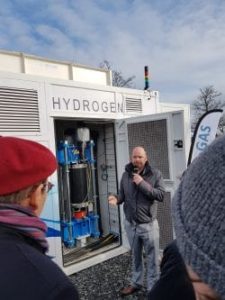Revealing the Power of Hydrogen: A Fundamental Overview

Introduction:
At a time when the world is actively seeking sustainable and clean energy solutions, the search for the fuel of the future is becoming increasingly crucial. Among the contenders, hydrogen emerges as a compelling option due to its potential to revolutionise industries and significantly reduce carbon emissions. In this article, we will embark on an exploratory journey into the realm of hydrogen as a possible fuel of the future. By examining its properties, applications and ongoing developments, we seek to shed light on whether hydrogen really holds the key to a greener, more sustainable world.
I. Unlocking the Power of Hydrogen: A Fundamental Overview
A. Hydrogen 101: Understanding the Basics
Hydrogen is the lightest and most abundant chemical element in the universe. Its atom is made up of one proton and one electron, making it a potentially clean source of energy. Hydrogen is found in various forms, such as molecular hydrogen (H2) and atomic hydrogen (H), and can combine with other elements to form compounds.
B. Production Methods: Unlocking the Potential
Hydrogen can be produced through several methods, the most common being steam methane reforming and water electrolysis. In steam methane reforming, methane (CH4) is combined with water vapour (H2O) to produce hydrogen and carbon dioxide (CO2). In electrolysis, on the other hand, electricity is used to break down water into hydrogen and oxygen.
C. The Promise of Clean Energy:
Hydrogen’s Environmental Impact
One of the main advantages of hydrogen as a fuel is its low environmental impact. When burned, hydrogen produces only water vapour as a by-product, which means that it generates no carbon emissions or air pollutants. In addition, hydrogen can be produced using renewable energy sources, such as solar or wind power, making it a truly clean and sustainable energy source.
II. Hydrogen Applications: Powering the Energy Revolution
A. Transport: Driving the Transition
Hydrogen has great potential as an energy source in the transport sector. Hydrogen fuel cell vehicles (FCHVs) use fuel cells to convert hydrogen and oxygen into electricity, which powers the vehicle and emits only water vapour. These vehicles offer faster recharge times and longer range compared to battery electric vehicles, making them attractive for long-range applications.
B. Energy Storage: Balancing the Grid
Hydrogen can also play an important role in renewable energy storage. Electricity generated from renewable sources, such as solar and wind, can be used to produce hydrogen through electrolysis. This hydrogen can be stored and subsequently used at times of high energy demand or when renewable generation is low. It acts as a form of long-term storage and helps to balance the electricity grid.
C. Industrial Sector: Decarbonisation and Efficiency
Hydrogen has significant applications in various industrial sectors. In steel production, hydrogen can replace coke coal, reducing the associated carbon dioxide emissions. Similarly, in ammonia production, hydrogen is used to synthesise nitrogen and hydrogen, a key process in the manufacture of fertilisers. In addition, in the petrochemical sector, hydrogen can be used as a feedstock to produce chemicals.
III. Challenges and Pathway to Hydrogen Adoption
A. Cost and Efficiency: Crucial Considerations
One of the main challenges to the widespread adoption of hydrogen is the cost of production and distribution. Currently, conventional methods of hydrogen production are expensive and consume considerable energy. However, technological advances and improvements in the efficiency of production processes are being made to reduce costs and make hydrogen more competitive with conventional fuels.
B. Infrastructure and Storage: Barriers to Overcome
The lack of hydrogen infrastructure is another key challenge. The construction of hydrogen refuelling stations to supply fuel cell vehicles is required, as well as the development of hydrogen distribution networks to supply industry and households. In addition, safe and efficient hydrogen storage is essential for large-scale application. Various storage technologies are being investigated, such as metal hydride storage and liquid hydrogen storage.
C. Regulatory Framework and Supporting Policies
To drive hydrogen adoption, supportive policies and regulations are crucial. Many governments and organisations are implementing strategies and support programmes that include financial incentives, tax exemptions and funding for research and development projects. In addition, international collaboration and cooperative agreements are essential to promote the exchange of knowledge and experience in the hydrogen field.
Conclusion:
Hydrogen presents itself as a promising candidate for the fuel of the future, thanks to its potential to reduce carbon emissions and its ability to store renewable energy. Although there are challenges to overcome, such as cost and infrastructure, hydrogen is gaining momentum in a number of sectors, including transport and industry. With technological advances, government support and global collaboration, hydrogen is likely to play a crucial role in the transition to a cleaner, more sustainable energy future.
I hope this article has provided a more detailed and comprehensive overview of hydrogen as the fuel of the future.

























